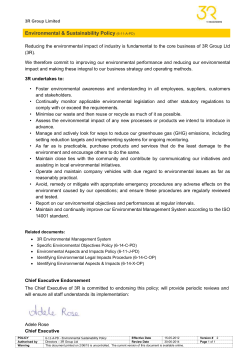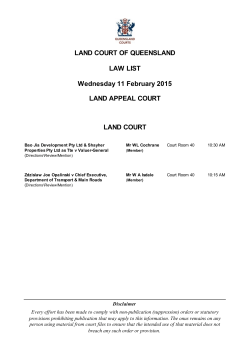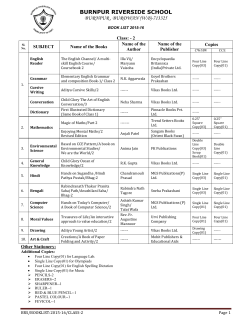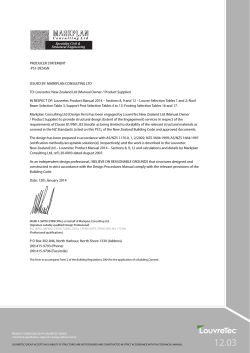
Hill & Redman`s Law of Landlord and Tenant
R May 2015 Hill & Redman’s Law of Landlord and Tenant Bulletin Editor Nicholas Roberts, BA, LLM, PhD, Solicitor and Notary Public Associate Professor, School of Law, University of Reading This Bulletin includes material available up to 30 April 2015. Filing Instructions: Please file immediately behind the Bulletins Guidecard in Binder 5. The Binder should now contain Bulletins 109 to 111. DIVISION A: GENERAL LAW Order for possession – alleged unlawful discrimination under the Equality Act 2010 (EA 2010) – whether same threshold as was applicable under Article 8 of the ECHR should be used to filter out unmeritorious defences Akerman-Livingstone v Aster Communities Ltd (formerly Flourish Homes Ltd) [2015] UKSC 15 is the appeal to the Supreme Court against the decision of the Court of Appeal reported as [2014] EWCA Civ 1081 (and noted in Bulletin No 108). It deals with the test to be applied in deciding whether a defendant has raised an issue of alleged unlawful discrimination under the EA 2010 which needs to be determined at a full hearing, and, in particular, whether defences under the EA 2010 which are likely to fail can be ‘filtered out’ by applying the same high threshold test as is applied to defences raising arguments under Article 8 of the ECHR. The facts of the case were that A-L was suffering from a ‘severe prolonged duress stress disorder’ and was also homeless. The local authority agreed that it owed a duty to him, which it had satisfied by securing temporary housing for him with Aster. Aster wished him to move from that temporary accommodation to more permanent accommodation, but A-L declined on the basis that he could not cope with what this would entail. Eventually the local authority argued that they had discharged their duty to him, as he had failed to accept suitable accommodation, which was one of the events which is specified as bringing their duties to an end (he had in fact refused numerous offers). A-L argued that the bringing of possession proceedings against him amounted to discrimination against him as a disabled person under s 15 of HR: Bulletin No 111 Letterpart Ltd • Typeset in XML • Division: HR_BulletinNo111 • Sequential 1 Letterpart Limited • Size: 242mm x 162mm • Date: April 30, 2015 • Time: 13:31 Bulletin No 111 L the EA 2010. HHJ Denyer in the Bristol County Court refused to let the matter go to a full trial. He held that the procedure to be adopted when a defence was based on alleged disability discrimination under the EA 2010 should be the same as when a defence based on Article 8 of the ECHR. As the Supreme Court in Pinnock and Powell had set a high threshold there, the same test should apply in cases where discrimination under the EA 2010 was alleged. On that basis, HHJ Denyer made a summary order, as A-L did not have a seriously arguable case. Cranston J agreed with this order, as did the Court of Appeal. The Supreme Court (Lord Neuberger, PSC, Lady Hale, DPSC, Lord Clarke, Lord Wilson and Lord Hughes) unanimously dismissed the appeal, though their judgments unanimously uphold A-L’s argument on the law to be applied. Giving the lead judgment, Lady Hale points out that there are in fact substantial differences between Article 8 and the EA 2010. The former applies only to public authorities, whereas s.35 EA 2010 applies in the private as well as the public sector, [24]. Article 8 requires equal treatment, whilst ss 15 and 35 of the EA 2010 require that disabled people should be protected from direct or indirect discrimination in relation to eviction, and so may have to be afforded rights where non-disabled people would not, [25]. Although proportionality considerations would come into play under the EA 2010, a further difference lies with the burden of proof. With the Human Rights Act 1998 the general position is that, ‘once an interference with a protected right is established, the burden of proof shifts to the public authority to prove that the interference is justified’,[33], but in Pinnock and Powell the Supreme Court had held that, in cases where social landlords taking possession proceedings against tenants who otherwise had no right to remain in the property, it could ‘generally be taken for granted’ [34] that the landlord was pursuing its twin aims of vindicating its property rights and complying with its statutory obligations to secure the appropriate use of its housing stock. But this could not generally be taken for granted as sufficient reason for a landlord faced with a disability discrimination defence, [34]. In practice this would mean that, whilst it might occasionally be possible for a case raising a defence based on the EA 2010 to be dealt with summarily, unlike with Article 8 defences, such cases were likely to be rare (Lady Hale at [36], Lord Neuberger at [59]), unless the landlord could show that there was no real prospect of the defendant proving that he was disabled, or it was plain that possession was being sought for some other reason, or bringing the claim was plainly a proportionate means of achieving a legitimate aim. Having thus in effect decided the point of procedure in favour of the defendant, the Supreme Court nevertheless dismissed the appeal, as the defendant’s expert chartered psychologist had recommended that he should receive therapy to enable him to accept his forced change of home; he was, however, declining it, and he had apparently refused an offer of alternative accommodation in the very street where he was currently living. Further, the claimant no longer had a leasehold interest in the defendant’s flat, and was required to give it up in order to comply with its own legal obligations. Although ordinarily one would expect the Supreme Court to remit the case to 2 Letterpart Ltd • Typeset in XML • Division: HR_BulletinNo111 • Sequential 2 Letterpart Limited • Size: 242mm x 162mm • Date: April 30, 2015 • Time: 13:31 DIVISION A: GENERAL LAW R the County Court to determine the issues, here it was inevitable that a possession order would have to be made, and it would be ‘no kindness’ to the defendant to prolong the agony. The present editor has previously observed that the county court has not found it as easy as the Supreme Court has indicated that it should be to apply the ‘high threshold’ to filter out unmeritorious claims raising defences under Article 8. It would seem that, if defendants raise any defence invoking disability discrimination then it is unlikely that a possession claim can be dealt with summarily. (noted at: NLJ 2015, 165(7645), 5; EG 2015, 1516, 85; and JHL 2015, 18(3), D54-D55) Striking out of possession claim for non-attendance at Directions Hearing – order subsequently set-aside – whether judge had applied correct test under CPR 3.9 for reinstatement of claim Home Group Ltd v Matrejek [2015] EWHC 441 (QB) offers guidance on the application of the amended provisions of CPR 3.9, which require the Court, when considering applications to grant relief from sanctions, to have particular regard for the need for litigation to be dealt with justly and at proportionate cost, and the need to enforce compliance with rules, practice directions and orders. The claimant landlord had failed to attend a Directions Hearing before the Circuit Judge. Its claim had been struck out, but later relief was granted from the sanction, and its claim re-instated. The defendant appealed against that decision. When the application for relief was heard the leading authority was recognised to be Mitchell v News Group Newspapers [2013] EWCA Civ 1537 (‘Mitchell’), but it was common ground in the instant appeal that the appeal had to be decided in accordance with Mitchell as subsequently clarified and amplified by the conjoined appeals in Denton v TH White Ltd [2014] EWCA Civ 906 (‘Denton, Decadent & Utilise’). Sweeney J held that the Circuit Judge in the County Court had correctly applied CPR 3.9(a) and (b), had not given too much or too little weight to other circumstances and he had not taken into account irrelevant considerations. The correct test to apply was Mitchell, as clarified by Denton, Decadent & Utilise. The defendant’s appeal was therefore dismissed. Forfeiture for breach of covenant against using premises without planning permission – whether relief should be granted when tenant was genuinely unaware that he was continuing to be in breach – weight to be attached to ‘windfall’ argument Ul-Hassan v Magnic Ltd [2015] EWCA Civ 224 is the latest episode of a dispute which had been going on since 2008. The defendants’ son had acquired by assignment the sublease of a property for 16 years from 2002. 3 HR: Bulletin No 111 Letterpart Ltd • Typeset in XML • Division: HR_BulletinNo111 • Sequential 3 Letterpart Limited • Size: 242mm x 162mm • Date: April 30, 2015 • Time: 13:31 DIVISION A: GENERAL LAW L The defendants had subsequently acquired the headlease, which was for a term of 125 years from 1980, at a ground rent. The headlease therefore had a substantial capital value (a figure of £150,000 is mentioned). The defendants’ son operated a pizza takeaway on the premises without planning permission, which was a breach of the usual covenant under both the head lease and the sublease. When planning permission was applied for, there were problems over installing a suitable ventilation system. Space does not permit a detailed description of the course of the proceedings, and the various occasions upon which the matter returned to court. The present appeal was against an order of HHJ Powles QC of 23 September 2013 in which he had dismissed an appeal against an order of DJ Jenkins of 8 August 2012, refusing the defendants’ application for relief from forfeiture of the headlease. The principle of wider interest which emerges from the decision of the Court of Appeal is that protracted non-compliance with conditions which have been imposed to secure relief from forfeiture is not necessarily sufficient to determine that further relief should not be granted. In the instant case, although the defendants’ son had continued to trade when he ought not to have done so, he had genuinely (and on legal advice) believed that a compromise agreement had entitled him to do so. In order to shut oneself out from the indulgence of the court conduct had normally to be deliberate. When a previous appeal had confirmed that he was not entitled to continue trading, he had promptly ceased to do so, illustrating that his continued breach was not to be characterised as deliberate. His continued trading had not harmed the claimants in any way. The District Judge had had regard to the windfall that forfeiture would give to the claimants, and had nevertheless refused relief. The Court of Appeal seemed to imply that, if the continued breach was not so culpable, the windfall argument would then be of greater significance. Relief was therefore granted, but on condition that the defendants paid costs which had been awarded against them at earlier stages of the proceedings. Jurisdiction of FTT to determine service charge disputes referred to it by the County Court – whether the FTT had jurisdiction to determine a point of lease construction once the financial dispute had been settled Cain v Islington LBC [2015] UKUT 0117 (LC) raises an interesting point on the jurisdiction of the FTT to determine service charge disputes. A dispute between C – a long leaseholder under a Right To Buy lease – and the council had been referred by the County Court to the FTT. The parties agreed that the issues to be determined were: ● the amount payable as C’s share of the cost of installing a new door entry system; and ● the basis upon which the costs relating to the building should be apportioned, following the abolition of domestic rates. The amount to be paid by C was agreed, but the parties continued with the case so that there could be a ruling to resolve their difference of opinion over 4 Letterpart Ltd • Typeset in XML • Division: HR_BulletinNo111 • Sequential 4 Letterpart Limited • Size: 242mm x 162mm • Date: April 30, 2015 • Time: 13:31 DIVISION A: GENERAL LAW R how future charges should be apportioned. C was not happy with the FTT’s decision, and obtained permission to appeal; at the appeal the Council argued that, as the actual matter which had been referred to the FTT had been settled, the FTT no longer had any jurisdiction to rule on the broader issue. Mr Martin Rodger QC, Deputy President, stressed that it was not appropriate for the FTT to take too pedantic a line on what issues fell within its scope when a dispute was referred to it, [17], especially when there was no indication that the County Court was deliberately reserving certain issues to itself. When the question of the amount of the service charge which was owed was transferred to the FTT, this necessarily would have involved the FTT in ruling, if necessary, on the apportionment issue, [18]. But once the amount that was payable was agreed, the broader issue fell away, and so the FTT had had no jurisdiction to rule upon it, [19]–[20]. The same conclusion would be reached if one considered the position under s 27A of the Landlord and Tenant Act 1985 (LTA 1985), [21]–[22]. The appeal would therefore have to be allowed, and the decision of the FTT on the apportionment question set aside, as it went outside the FTT’s jurisdiction. It would seem inevitable that the matter of the apportionment would have to be brought back again to the FTT, as a result of some rather ambiguous drafting of a clause dealing with the method of apportionment to be adopted if domestic rates should be abolished. The moral of the decision would appear to be that parties to FTT service charge disputes should be wary of compromising disputes if their underlying wish is to obtain a ruling on a matter of wider import. This may go against the current emphasis on ADR, but for this and other reasons, ADR may have limited utility for many disputes which go before the FTT. Limitation period and service charge accounts – principles to be applied with appropriation by lessor and communication to lessee One Housing Group Ltd v Wright [2015] UKUT 0124 (LC) raises the often fraught issue of the application of limitation periods to service charge accounts. The FTT had determined that the oldest of the arrears which OHG, the landlord, was claiming, were statute-barred. OHG thereupon applied to the FTT to review its decision, or alternatively to grant permission to appeal. In view of the potentially wider significance of the matters at issue, the FTT granted permission to appeal. The UT (HHJ Edward Cousins) accepted the finding of the FTT that the service charge had been reserved as rent, and that therefore the limitation period of six years under the Limitation Act 1980 applied. The FTT accepted, as did the UT, that a landlord such as OHG was entitled, in the absence of any election by the debtor, to appropriate any payment to any debt, and could therefore set it against the earliest debt, provided that such decision was communicated to the debtor. OHG’s appeal was therefore based 5 HR: Bulletin No 111 Letterpart Ltd • Typeset in XML • Division: HR_BulletinNo111 • Sequential 5 Letterpart Limited • Size: 242mm x 162mm • Date: April 30, 2015 • Time: 13:31 DIVISION A: GENERAL LAW L on the way that the FTT had analysed the limitation point and applied the law to the facts. On the facts, the appeal was therefore allowed. Service charge dispute – whether failure to produce accounts and to comply with s 47 of the Landlord and Tenant Act 1987 (LTA 1987) rendered demands irrecoverable Estates of holiday cottages in Cornwall seem to offer fertile ground for service charge disputes (c f Phillips v Francis [2014] EWCA Civ 1395: see Bulletin No 109), and Pendra Loweth Management Ltd v North [2015] UKUT 0091 (LC) offers a further example. The service charge provisions in the leases of the cottages followed a familiar pattern, envisaging an estimated service charge, followed by balancing charges once the accounts had been audited. The problem faced by the FTT when a service charge dispute came before it was that the management company had largely ignored these provisions, and had attempted to collect the charges in a much less elaborate way, relying on the company accounts of the management company rather than a separate service charge account: but this then caused difficulties, because the company itself ran a café, bar, shop, etc, and takings from these also appeared in the accounts. Further, the FTT held that the service charges were irrecoverable as the Management Company had failed to comply with s 47 of the LTA 1987 in that it had not included the name and address of the landlord in its demands for the service charge. The Management Company appealed, and succeeded before the UT (Mr Martin Rodger QC, Deputy President). Although he deprecated the failure of the Management Company to comply with the terms of the lease, and with the various provisions that it had to comply with to safeguard the interests of the leaseholders, the Management Company’s entitlement to collect the service charge contributions was not, in this lease, expressed to be conditional upon its strictly observing the requirement to have the service charge accounts audited, nor was it ‘contaminated’ by the inclusion of extraneous matters in its accounts. Further, s 47 of the LTA 1987 only applied to a payment of rent or some other sum of money to a landlord. This term was defined in s 60(1) as meaning an ‘immediate landlord’ and there was nothing to extend its meaning to someone else with the right to enforce the payment of a service charge (cf s 30 of the LTA 1985), such as a management company under a tripartite lease. The appeal was therefore allowed, and the matter referred for reconsideration by the FTT. Licensing of Houses in Multiple Occupation under the Housing Act 2004 (HA 2004) – whether Rent Repayment Order could be made against the sub-tenant of an individual unit Urban Lettings (London) Ltd v Haringey LBC [2015] UKUT 0104 (LC) is an important decision of the scope and applicability of the regime set up by the 6 Letterpart Ltd • Typeset in XML • Division: HR_BulletinNo111 • Sequential 6 Letterpart Limited • Size: 242mm x 162mm • Date: April 30, 2015 • Time: 13:31 DIVISION A: GENERAL LAW R HA 2004 to allow local authorities to regulate Houses in Multiple Occupation (HMOs). The legal and factual set-up of the building in question was as follows: the freehold of the property was owned by H: she was not a relevant party. The ground floor was used for commercial purposes. Each of the three floors above was let on a separate 125 year lease to a company, CPR. On each of these floors there were four self-contained residential units. Each of these 12 units was separately sub-let to ULL for a term of just over three years from March 2011. Communal areas (corridors and steps) were not included in any of the sublettings. The units were let and managed by ULM as agents for ULL: ULL and ULM were companies in the same group and had the same directors. This exposition of the facts suggests the nature of the point of law in dispute! It was accepted that each floor of the premises was itself an HMO for the purposes of s 257 of the HA 2004. Each floor should therefore have been licensed, but no such licences had been granted. The Property Chamber of the FTT had therefore made a Rent Repayment Order under s 73(5) of the HA 2004 against ULL in the sum of £16,000, in respect of Housing Benefit payments received. Similar applications against CPR and ULM were dismissed. ULL appealed on two grounds: first, that the FTT was wrong in finding that ULL was a person having control of the premises; and second, that the FTT had erred in deciding that ULL had committed an offence under s 72(1) of the HA 2004, as the FTT had not considered whether ULL might have had a statutory defence under s 72(5) (ie that it might have had a reasonable excuse for not complying). The UTl (HHJ Behrens) dealt shortly with the second ground of appeal. The defence had not been raised by ULL before the FTT, so the FTT was not obliged to deal with it of its own initiative, [24]. It would in any event be no excuse to suggest that a licence could not have been granted to ULL as they would have been unable to comply with whatever conditions might have been imposed, as the whole purpose of the licensing regime was to ensure compliance with conditions. HHJ Behrens accepted that the first ground of appeal raised difficult questions on the construction of the statute which might have far-reaching and potentially wide implications. Section 61(7) of the HA 2004 contains the definition of a person having control of an HMO for the purposes of Part 2 of the Act, and is the person who receives the rack rent of the HMO whether on his own account or as an agent or trustee of another person. The definition is therefore different from the definition in s 263(1), the second limb of which includes a reference to ‘a person who would receive the rack rent if the premises were let at a rack-rent’. It was accepted that there were no authorities on s 61(7), but the Tribunal was referred to long-standing authorities on words equivalent to those in the second limb of s 263(1), including s 39(2) of the Housing Act 1957, which was considered in Pollway Nominees v Croydon LBC [1987] AC 79. HHJ Behrens felt that this and other cases established that the Court should ‘give effect to the policy of the legislation and [..] avoid a situation where no-one is responsible for the relevant obligations’, [57]. The UT therefore dismissed the appeal. In answer 7 HR: Bulletin No 111 Letterpart Ltd • Typeset in XML • Division: HR_BulletinNo111 • Sequential 7 Letterpart Limited • Size: 242mm x 162mm • Date: April 30, 2015 • Time: 13:31 DIVISION A: GENERAL LAW L to the argument of ULL that this could have the result that ULL would not be granted a licence, as it would not be in a position – as lessee of the units, but not of the common parts – to comply with conditions, HHJ Behrens said that’ the short answer [was] that ULL should not have entered into an arrangement whereby they could not comply with the licensing obligations in Part 2 of the 2004 Act’, [63]. Possession proceedings following termination of licence to occupy RAF married quarters – whether amounting to discrimination under Article 14 of the ECHR Nicholas v Secretary of State for Defence [2015] EWCA Civ 53 relates to the termination of a licence granted by the Crown to occupy Royal Air Force married quarters, so it arguably does not fall within the scope of the principal work. It is, however, noted briefly, as the Court of Appeal (Lord Dyson, MR, and Pitchford and Lewison, LJJ) held that the taking of possession proceedings against Mrs Nicholas after the breakdown of her marriage to her RAF Officer husband did not amount to discrimination under Article 14 of the ECHR. (case noted at: JHL 2015, 18(3), D62-D63) DIVISION C: PRIVATE SECTOR RESIDENTIAL TENANCIES Swanbrae Ltd v Ryder [2015] UKUT 0069 (LC) is the landlord S’s appeal to the UT (Mr Martin Rodger QC, Deputy President) against the FTT’s refusal to hear a reference of its notice to increase the rent of the relevant premises to a market rent. Between 1994 and 2013 notices of increase of rent given under s 14 of the Housing Act 1988 (HA 1988) had been referred to rent assessment committees and on four of those occasions the rent was increased. In 2013 the appellant sought a further increase but the FTT struck out the application on the basis that it did not have jurisdiction. The basis of this refusal was that R’s tenancy was a regulated tenancy under the Rent Act 1977 and not an assured tenancy under the HA 1988. The tenancy between S and R had originally been granted as part of a consent order concluded in 1994 within possession proceedings brought by S against R. The FTT took the view that, if R had had Rent Act protection prior to 1989 then the effect of the transitional provisions of the HA 1988 (para 1 of Sch 1) would be that R would continue to enjoy Rent Act protection regardless of the intention of the parties; and that even if the agreement formed part of a consent order, the tenancy derived its validity from the parties’ agreement, not from the decision of the court, [20]. The Deputy President took the view that the FTT was correct not to accept jurisdiction without satisfying itself that it was proper for it to do so, [29]. However, R would continue to enjoy Rent Act protection only if the circumstances fell within s 34(1)(b) of the HA 1988. This required that two 8 Letterpart Ltd • Typeset in XML • Division: HR_BulletinNo111 • Sequential 8 Letterpart Limited • Size: 242mm x 162mm • Date: April 30, 2015 • Time: 13:31 DIVISION A: GENERAL LAW R conditions be satisfied: that R was a protected or statutory tenant immediately before the grant of her new tenancy, and that S was her landlord, [31]. On closer examination, the indications were that R had been S’s sub-tenant, [33]–[43]. The conditions of s 34(1)(b) were not therefore met, and the referral of the notice of increase of rent should therefore be sent back to the FTT so that it might determine the matter. Licensing of Houses in Multiple Occupation under the HA 2004 – whether Rent Repayment Order could be made against the sub-tenant of an individual unit See Urban Lettings (London) Ltd v Haringey LBC [2015] UKUT 0104 (LC) in Division A DIVISION E: LONG LEASES Collective enfranchisement – whether failure to register initial notice rendered it invalid once freehold had been transferred back to its original recipient – whether landlord could resile from terms once agreed but before all had been agreed Curzon v Wolstenholme [2015] UKUT 0173 (LC) is an appeal by the landlord C to the UT on two points relating to an application for collective enfranchisement by the owners of four of six flats created out of a large terraced property (one of the flats was held by C’s wife and one by C and his wife jointly). There was a history of previous litigation, and it was clear that C was determined to try to prevent an enfranchisement. When the initial notice under s 13 of the Leasehold Reform, Housing and Development Act 1993 (LRHUDA 1993) was served (in 2004), W and the other participating leaseholders had failed to register the initial notice at the Land Registry, as permitted by s 97(1) of the LRHUDA 1993. In 2012 C sold the freehold to his wife for £1, and a few months later C transferred the freehold back to C by way of gift. C argued that as a result of this transaction the right to acquire the freehold could no longer be enforced. The FTT had rejected this argument, and Mr Martin Rodger QC, Deputy President, dismissed C’s appeal on the point. Essentially he held, [33], that s 13(11) of the LRHUDA 1993 set out a comprehensive list of circumstances in which the initial notice would cease to have effect. Further, [34], ‘the ability to protect rights under the Act by registration does not require that, by implication, a failure to protect those rights necessarily results in them being lost not only against a successor in title of the recipient of the initial notice, but also against the recipient themselves.’ The other issue which was raised on appeal is whether, having agreed certain terms for the acquisition of the freehold, the landlord could then resile from that agreement if all terms had not been agreed. Again the Deputy President agreed with the FTT that a landlord could not. Although, once agreed, such terms remained technically ‘subject to contract’ (in the sense that there was 9 HR: Bulletin No 111 Letterpart Ltd • Typeset in XML • Division: HR_BulletinNo111 • Sequential 9 Letterpart Limited • Size: 242mm x 162mm • Date: April 30, 2015 • Time: 13:31 DIVISION E: LONG LEASES L no enforceable contract under the Law of Property (Miscellaneous Provisions) Act 1989 which could be subject to specific performance), in spite of these conceptual difficulties, [52], the scheme of the LRHUDA 1993 was that only matters which were not agreed should fall to be determined by the FTT, and, to give practical effect to the Act, once a term was agreed it was not open to the parties to resile from it, [54]–[56]. C’s appeal therefore failed on both grounds. Right to Manage under the Commonhold and Leasehold Reform Act 2002 (CLRA 2002) – whether a single RTM company could manage more than one building on the same estate Triplerose Ltd v Ninety Broomfield Road RTM Co Ltd; Freehold Managers (Nominees) Ltd v Garner Court RTM Co Ltd; Proxima GR Properties Ltd v Holybrook RTM Co Ltd [2015] EWCA Civ 282 is an important decision holding that – contrary to the decision of the UT – different buildings within one estate may not opt to exercise the Right to Manage (RTM) under the CLRA 2002 via a single RTM Company. There have been conflicting decisions over the years in the LVTs (now the FTT) and the UT (Ms Siobhan McGrath, President of the Property Chamber of the FTT, sitting as a Judge of the Upper Tribunal) decided in Ninety Broomfield Road RTM Co Ltd v Triplerose Ltd [2013] UKUT 0606 (LC) (noted in Bulletin No 103) that a purposive construction had to be placed on ss 72–74 of the CLRA 2002, and whilst the criteria for eligibility to claim the RTM had to be determined by a strict building by building approach, provided they were satisfied, there was no reason why a single RTM company might not then exercise the RTM. The Court of Appeal (Pattern and Gloster LJJ, and Sir David Keene) disagreed. The first line of reasoning of Gloster LJ, who gave the sole judgment, was that the same meaning had to be given to ‘premises’ wherever it appeared in ss 72–74 of the CLRA 2002. If it were not, then there would be nothing to prevent blocks of flats with no geographical proximity to each other from claiming the RTM. Ms McGrath had considered this possibility to be ‘fanciful’ but Gloster LJ felt that it was an important consideration [51]. Allowing a joint RTM would also allow the leaseholders in a smaller block to be dominated by the leaseholders in a larger block, so denying the leaseholders in the smaller block the right to self-management which the CLRA 2002 had intended; moreover, there would be nothing that the leaseholders in the smaller block could do about this situation, as s 73(4) precluded a further application for the RTM against an existing RTM company, [53]. The Court of Appeal also took support from the Consultation Paper which was issued by the Government before the CLRA 2002 was enacted. Although the UT had also been referred to this, the Court of Appeal took the view that, although ss 72–74 were unambiguous, if there were any ambiguity, then the Consultation Paper pointed towards not permitting a joint RTM Company, [55],[56]. Further, Hansard (to which the UT had not been taken) strongly indicated that a joint RTM was not permissible, as an amendment 10 Letterpart Ltd • Typeset in XML • Division: HR_BulletinNo111 • Sequential 10 Letterpart Limited • Size: 242mm x 162mm • Date: April 30, 2015 • Time: 13:31 DIVISION E: LONG LEASES R explicitly allowing for it had been withdrawn in the face of Government opposition, [57], [58]. It was also pointed out, [60], that adopting a strict building by building approach would be consistent with the approach taken in various County Court decisions on collective enfranchisement, and supported by Hague on Leasehold Enfranchisement, 6th edn 2014, para 21–02. The decision of the Court of Appeal answers some objections, but creates further difficulties. The UT in the instant case had considered that the previous Court of Appeal decision in Gala Unity Ltd v Ariadne Road RTM Co Ltd [2012] EWCA Civ lent support to a broader view of ss 72–74; here, however, the Court of Appeal thought that its ratio was restricted to whether the RTM might extend to appurtenant property. (The facts of Gala involved two buildings jointly exercising the RTM, but the point had not been taken as a ground of objection). This would, however, seem to raise the possibility (which the CA did not explicitly address) of more than one RTM Company concurrently having the right to manage parts – perhaps communal gardens, drives, or parking areas – which are common to more than one set of premises. The CA’s only answer would seem to be, [54], that there is nothing in the RTM which prevent one RTM Company from appointing the other as its agent, or from RTM Companies appointing a common managing agent. But this of course requires co-operation where there may be no will to do so. The decision also seems to sit rather uneasily with the decision of the CA in Craftrule Ltd v 41–60 Albert Place Mansions (Freehold) Ltd [2011] EWCA Civ 185, which held that the RTM might be exercised in respect of a self-contained part of a building which could itself be sub-divided into two or more different self-contained parts for RTM purposes. This decision was not referred to in the judgment in the instant case. There are undeniably problems either with a strict block-by-block approach, or a more flexible approach. It remains to be seen how this decision works in practice. It may be that ultimately more elaborate legislative machinery will be needed to cope with the difficulties posed by estate-wide facilities; that such legislation would not be easy to draft is somewhat of an understatement. NOTES ON CASES Akhverdiyev v Azerbaijan (76254/11) Unreported (ECHR): JHL 2015, 18(3), D61-D62 Anchor Trust v Corbett [2014] UKUT 510 (LC): JHL 2015, 18(2), D39-D40 (noted in Bulletin No 109) Assethold Ltd v Watts [2014] UKUT 537 (LC): JHL 2015, 18(2), D40 (noted in Bulletin No 109) Boots UK Ltd v Goldpine Estates Ltd [2014] EWCA Civ 1565: [2015] L & T Review 72–75 Charalambous v Ng [2014] EWCA Civ 1604; [2015] HLR 15: JHL 2015, 18(2), D45; and [2015] L & T Review 68–70 (noted in Bulletin No 109) 11 HR: Bulletin No 111 Letterpart Ltd • Typeset in XML • Division: HR_BulletinNo111 • Sequential 11 Letterpart Limited • Size: 242mm x 162mm • Date: April 30, 2015 • Time: 13:31 NOTES ON CASES L Columbia House Properties (No.3) Ltd v Imperial Hall Freehold Ltd [2015] UKUT 45 (LC): JHL 2015, 18(3), D64-D65 Crossfield v Jackson [2014] EWCA Civ 1548; [2015] HLR 13: JHL 2015, 18(2), D46-D47 Crowther v Rayment [2015] EWHC 427 (Ch): [2015] Comm Leases 2169–2170 Edwards v Kuramamy [2015] EWCA Civ 20: NLJ 2015, 165(7645), 11–12; [2015] L & T Review D10; and JHL 2015, 18(3), D53-D54 (noted in Bulletin No 110) Enfield LBC v Najim [2015] EWCA Civ 319: JHL 2015, 18(3), D58 Greenwich LBC v Tuitt [2014] EWCA Civ 1669; [2015] HLR 10: JHL 2015, 18(2), D29-D30 Home Group Ltd v Matrejek [2015] EWHC 441 (QB): JHL 2015, 18(3), D51-D52 Hough v Greathall Ltd [2015] EWCA Civ 23: SJ 2015, 159(9), 12–13; [2015] Comm Leases 2157–2158; EG 2015, 1511, 106; and [2015] L & T Review 70–72 (noted in Bulletin No 110) Lambeth LBC v Loveridge [2014] UKSC 65: [2014] 1 WLR 4516: JHL 2015, 18(2), D47-D48 (noted in Bulletin No 109) Lawal v Circle 33 Housing Trust [2014] EWCA Civ 1514: [2015] HLR 9: JHL 2015, 18(2), D36-D37 (noted in Bulletin No 109) Merie Bin Mahfouz Co (UK) Ltd v Barrie House (Freehold) Ltd [2014] UKUT 390 (LC): JHL 2015, 18(2), D42-D43; and EG 2015, 1510, 79 (noted in Bulletin No 109) Mitchell v Watkinson [2014] EWCA Civ 1472 (CA (Civ Div)): [2015] Comm Leases 2161–2164 (noted in Bulletin No 110) Natt v Osman [2014] EWCA Civ 1520; [2015] 1 WLR 1536: JHL 2015, 18(2), D38; and EG 2015, 1514, 85 (noted in Bulletin No 109) Oakrock Ltd v Travelodge Hotels Ltd [2015] EWHC 30 (TCC): [2015] Comm Leases 2151–2152 Obichukwu v Enfield LBC [2015] UKUT 64 (LC); [2015] RVR 123: Comm Leases 2164–2168 Reeves v Sandhu [2015] EWHC 985 (Ch): [2015] Comm Leases 2149–2150 R (on the application of Caws and Fort Management Co Ltd) v First-Tier Tribunal [2014] EWHC 3808 (Admin); [2015] L & TR 9: JHL 2015, 18(2), D38-D39 (noted in Bulletin No 109) R (on the application of MT) v Oxford City Council [2015] EWHC 795 (Admin): JHL 2015, 18(3), D51 R (on the application of N) v Lewisham LBC [2014] UKSC 62; [2014] 3 WLR 1548 (SC): JHL 2015, 18(2), 24–28 (noted in Bulletin No 109) 12 Letterpart Ltd • Typeset in XML • Division: HR_BulletinNo111 • Sequential 12 Letterpart Limited • Size: 242mm x 162mm • Date: April 30, 2015 • Time: 13:31 NOTES ON CASES R St Stephens Mansions RTM Co Ltd v Fairhold NW Ltd [2014] UKUT 541 (LC): JHL 2015, 18(2), D41-D42 (noted in Bulletin No 109) Salford Estates (No 2) Ltd v Altomart Ltd [2014] EWCA Civ 1575: [2015] Comm Leases 2152–2155 Solihull MBC v Hickin [2012] UKSC 39; [2012] 1 WLR 2295 (SC): JHL 2015, 18(2), 29–33 (noted in Bulletin No 95) Stolyarova v Russia (15711/13) unreported (ECHR): JHL 2015, 18(3), D62 Swiss Cottage (40) Properties Ltd v Primeestate Investments Ltd [2015] EWHC 520 (Ch): [2015] Comm Leases 2160–2161 Tindall Cobham 1 Ltd v Adda Hotels [2014] EWCA Civ 1215: [2015] L & T Review 62–63 (noted in Bulletin No 108) Uddin v Islington LBC [2015] EWCA Civ 369: JHL 2015, 18(3), D54 UK Leasing Brighton Ltd v Topland Neptune Ltd [2015] EWHC 53 (Ch): SJ 2015, 159(9), 33–34; and [2015] Comm. Leases 2155–2157 (noted in Bulletin No 110) ARTICLES OF INTEREST ADR takes the next step EG 2015, 1513, 74–76 A guide through the MEES minefield (Minimum energy efficiency standards in commercial buildings) EG 2015, 1516, 76–78 An English (leasehold) reformation? (considers conversion of long leasehold to freehold) EG 2015, 1511, 108 A patchwork landscape: residential and holiday parks, leasehold lodges and mobile homes – Part 2 [2015] L & T Review 64–67 Commercial landlords under new Government energy efficiency fire [2015] L & T Review 45–46 Conveyancer’s miscellany [2015] Conv 103–109 Disclaiming responsibility: Part 1 (disclaimer of leases as onerous property) [2015] L & T Review 58–61 Estoppel and tenancy status [2015] L & T Review 79–83 Horizontality of article 8in the context of possession proceedings EHRLR 2015, 2, 138–148 Landlords feel the heat (review of Heat Network (Metering and Billing) Regulations 2014 (SI 2014/3120)) EG 2015, 1511, 107 Navigating the residential seas (advice on landlord compliance with the Immigration Act 2014) EG 2015, 1509, 130–131 Not all legal provisions are created equal: considerations for housing associations faced with evicting a tenant with protected characteristics HLM 2015, Apr Supp (Social Housing Bulletin), ii-iii 13 HR: Bulletin No 111 Letterpart Ltd • Typeset in XML • Division: HR_BulletinNo111 • Sequential 13 Letterpart Limited • Size: 242mm x 162mm • Date: April 30, 2015 • Time: 13:31 ARTICLES OF INTEREST L Recent Developments in Housing Law Legal Action, February 2015, 37–42; March 2015, 42–46; April 2015, 41–46 Refusing requests to assign or sublet EG 2015, 1513, 77 Retaliatory evictions – predicting the effects of the Deregulation Bill JHL 2015, 18(3), 41–43 SDLT on the continuation and renewal of a lease: Part 2 [2015] L & T Review 52–54 Service charge apportionment and the FTT JHL 2015, 18(3), 44–47 Share of freehold: nirvana or nightmare? [2015] L & T Review 55–57 Taxing points to remember EG 2015, 1509, 133 The Mental Capacity Act: a new approach to capacity in tenancy agreements? JHL 2015, 18(3), 54–59 The politics of private rents EG 2015, 1516, 83 VAT traps for the unwary EG 2015, 1513, 78–79 NEWS AND CONSULTATIONS The Department for Communities and Local Government has published two further consultations. The first is about notifying leaseholders of their right to seek redress under government-approved redress schemes, by including information about it in the existing notice ‘Summary of Rights and Obligations’ (which is sent out with demands for service charges): https://www.gov.uk/ government/uploads/system/uploads/attachment_data/file/417848/ Discussion_paper_on_promoting_redress_schemes_to_leaseholders__Final__3_.pdf The consultation on this closes on 22 May 2015. The second is about what can be done to make it easier for leaseholders to obtain recognition for tenants’ associations, and whether existing guidelines on recognition need to be amended, and further legislation required: https:// www.gov.uk/government/uploads/system/uploads/attachment_data/ file/417786/150325_-_RTA_discussion_paper_-_final__2_pdf This consultation also closes on 22 May 2015. The Welsh Government has produced a draft Code of Practice for Landlords and Agents in relation to the provisions introduced in the Housing (Wales) Act 2014: http://gov.wales/docs/desh/consultation/150327-consultation-on-aprivate-rented-sector-code-of-practice-en.pdf. Landlord and agents in the private rented sector who hold a licence must comply with the Code of Practice. Comments are invited by 22 May 2015. OFFICIAL PUBLICATIONS The Department for Communities and Local Government on 13 March 2015 published a guide ‘Renting a safe home: a guide for tenants’ (https://www. gov.uk/government/publications/renting-a-safe-home-a-guide-for-tenants) and another ‘Improving the private rented sector and tackling bad practice: a 14 Letterpart Ltd • Typeset in XML • Division: HR_BulletinNo111 • Sequential 14 Letterpart Limited • Size: 242mm x 162mm • Date: April 30, 2015 • Time: 13:31 NEWS AND CONSULTATIONS R guide for local authorities’ (https://www.gov.uk/government/publications/ improving-the-private-rented-sector-and-tackling-bad-practice-a-guide-forlocal-authorities) The Department for Communities and Local Government has also published a response to the market study into residential property management services carried out by the Competition and Markets Authority (CMA) as it applies to England, the outcome of which was published on 2 December 2014. For the Department’s response, see https://www.gov.uk/government/uploads/system/ uploads/attachment_data/file/415861/Response_to_CMA_Market_Study.pdf PRACTICE GUIDES ETC The Land Registry has issued a new Practice Guide 27, on the leasehold reform legislation, which clarifies that a court order for variation under the Landlord and Tenant Act 1987 cannot be protected by a unilateral notice. PRESS RELEASES The Land Registry has issued a Press Release announcing two changes to the way in which land included in leasehold title is described in entry number 1 in the property register. The change took effect on 23 March 2015: https://www. gov.uk/government/news/changes-to-entry-1-in-the-property-register-forleasehold-titles STATUTORY INSTRUMENTS The Assured Tenancies and Agricultural Occupancies (Forms) (England) Regulations 2015, SI 2015/620, came into force on 6 April 2015. They set out certain forms to be used by tenants and landlords to propose new rent fees, and to apply for an assured tenancy to be replaced by an assured shorthold tenancy. The Allocation of Housing (Qualification Criteria for Right to Move) (England) Regulations 2015, SI 2015/967 came into force on 20 April 2015. They ensure that those who have to move in order to live nearer their place of work are not disqualified by reason of criteria requiring applicants for housing to have a local connection. The Energy Efficiency (Private Rented Property) (England and Wales) Regulations 2015, SI 2015/962 will come into force, in part, on 1 April 2016. The Regulation of Private Rented Housing (Designation of Licensing Authority) (Wales) Order 2015, SI 2015/1026 (W 75) came into force on 1 April 2015, and designates the County Council of the City and County of Cardiff as the licensing authority for the whole of Wales for the purposes of Part 1 of the Housing (Wales) Act 2014. The Act relates to the regulation of private rented housing in Wales. 15 HR: Bulletin No 111 Letterpart Ltd • Typeset in XML • Division: HR_BulletinNo111 • Sequential 15 Letterpart Limited • Size: 242mm x 162mm • Date: April 30, 2015 • Time: 13:31 STATUTORY INSTRUMENTS L Letterpart Limited • Size: 242mm x 162mm • Date: April 30, 2015 • Time: 13:31 Correspondence and queries about the content of Hill & Redman’s Law of Landlord and Tenant should be sent to Sarah Thornhill, Senior Editor, LexisNexis, Lexis House, 30 Farringdon Street Lane, London EC4A 4HH, tel: 020 7400 2736, email: sarah.thornhill@lexisnexis.co.uk. Subscription and filing enquiries should be directed to LexisNexis Customer Services, LexisNexis, PO BOX 1073, BELFAST, BT10 9AS. Tel 0(84) 5370 1234. Visit LEXISNEXIS direct at www.lexisnexis.co.uk © Reed Elsevier (UK) Ltd 2015 Published by LexisNexis Printed and bound in Great Britain by Hobbs the Printers Ltd, Totton, Hampshire ISBN 978-1-4057-9324-7 9 781405 793247 16 Letterpart Ltd • Typeset in XML • Division: HR_BulletinNo111 • Sequential 16
© Copyright 2025









